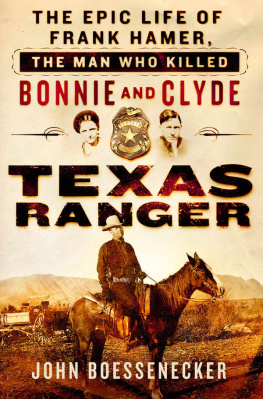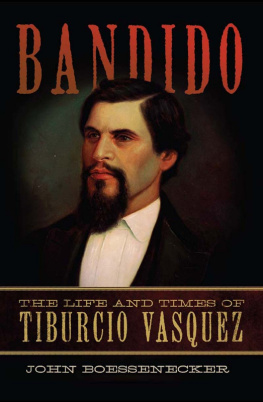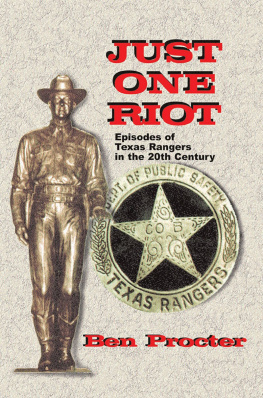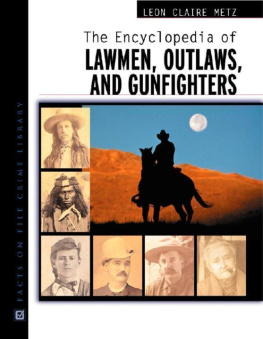

Thank you for buying this
St. Martins Press ebook.
To receive special offers, bonus content,
and info on new releases and other great reads,
sign up for our newsletters.

Or visit us online at
us.macmillan.com/newslettersignup
For email updates on the author, click here.
The author and publisher have provided this e-book to you for your personal use only. You may not make this e-book publicly available in any way. Copyright infringement is against the law. If you believe the copy of this e-book you are reading infringes on the authors copyright, please notify the publisher at: us.macmillanusa.com/piracy.
For Bobby and Randy
A late autumn breeze swept through the mesquite and the post oaks, rippling the surface of the stream. He leaned forward in the saddle as he spurred his horse up the riverbank. The musty scent of freshly harvested alfalfa hung in the air as the young cowboy cantered across the fields toward a cluster of small buildings along the rutted road.
He was a fine-looking youth, with sharp, angular features and a square jaw set off by piercing blue eyes and closely cropped light brown hair. He was big for a seventeen-year-old: six feet, two inches, tipping the scales at 190 pounds. Frank Hamer had not seen his family in a year, and he looked forward to returning home. For the occasion he wore his finest: a new Stetson hat, fancy neckerchief, high-heeled riding boots, and a hand-tooled belt. His parents house was just twenty-five miles away, and his journey almost done.
The ride had been a long one, more than two hundred miles from the open ranges of the Pecos to the Texas Hill Country, and was hard on man and horse. The buckshot wounds in his back were almost fully healed, but days in the saddle had caused a constant ache up and down his spine. He was relieved to see, in the midst of the board-and-batten houses, a small country store. Its walls of limestone blocks promised a cool place to rest, its covered wood porch respite from the midday sun.
And he needed to rest. He needed food for himself and feed for his animal. What he did not need was the crowd of toughs loitering about the storefront, leaning on the hitching rail, drifting in and out through the double doors.
There wasnt much to do on a lazy afternoon in Winchell, Texas, in 1901. Farmers and field hands gathered to swap lies, drink forty-rod whiskey, arm wrestle, raise a little hell, and maybe hooraw any young stranger who happened by. Young Hamer tried to pay them little heed as he reined up in front of the store and swung slowly from the saddle. He tied his horse to the hitching post and stepped up on the porch and pushed through the doors.
One of the crowd called out, Say, look there! That highpockets looks like he might give us a bit of fun!
My, my, aint he pretty, drawled another.
Hamer ignored them. From the storekeeper he bought a can of sardines, a tin of crackers, and a small sack of grain. He stepped back outside, filled his nose bag with oats, and hung it on his horses head. By now the crowd of roughs had surrounded him and his animal. One pointed at the youth and said, Why, he aint even wet behind the ears.
Someone get the tar, yelled another, referring to the vigilante custom of tar and feathers. Others discussed the quality of his cowboy attire. One said he would take Hamers spurs, another his belt, and another his hat. One rowdy threatened to yank off his boots and thrash him with them.
As his horse chewed, Hamer leaned calmly against the hitching rail. He drew his bowie knife and started to whittle a toothpick out of a match. The ringleader ignored the not-so-subtle warning and moved closer to him as one of the crowd hollered, Dont tear his britches. Theyll fit me just fine!
Hamer knew he had to do something decisive and unexpected. As the antagonist stepped even closer, Hamer drew back and spat full in his face. That stunned the man, and for a moment he hesitated. Someone in the crowd yelled out, Are you going to take it?
The man took a long look at Hamers unwavering gaze, his size, his steady hands, and the razor-sharp bowie in his fist. Then he wiped the spittle from his face and moved back. Calmly, slowly, Frank Hamer removed the nosebag, slipped on the bridle, and swung into the saddle. He turned his horses head and rode slowly out of town.
He had recognized instinctively that any sign of weakness would have left him at the crowds mercy. Of the ringleader, Frank recalled years later, Had he reached for me I would have made two pieces out of him. For the rest of his life, Hamer would take great pride in the way he had stood off the crowd. It was one of the few stories his friends could coax out of him.
Extremely modest and humble, Hamer left behind but scant correspondence and no diaries or journals. Even to his closest friends he rarely spoke of the violent events of his long career. Yet his story is not lost. It lives on in moldering court records, yellowed newspapers, obscure archives, and the forgotten memoirs of his fellow lawmen. So now the full history of Frank Hamers epic life appears in these pages for the first time.
Texas bred tough men, and none came any tougher than Frank Hamer. He was to the Lone Star State what Wyatt Earp was to Arizona and what Wild Bill Hickok was to Kansas. His iron strength was hammered on the anvil of his fathers blacksmith shop. His iron will was molded in forty tumultuous years as a peace officer. His iron character was honed by his struggles against horseback outlaws, Mexican smugglers, the Ku Klux Klan, corrupt politicians, the Texas Bankers Association, and Lyndon B. Johnson. His iron courage was forged in the flames of fifty-two gunfights with desperadoes. In an era when crooked police were a dime a dozen, he could not be bought at any price. Though a white supremacist of the Jim Crow era, he saved fifteen African Americans from lynch mobs. He was the greatest American lawman of the twentieth century.
Hamer was a son of the Hill Country, that undulating expanse of live oak, mesquite, and cedar brakes that stretches through central Texas from the Balcones Escarpment north and west to the Edwards Plateau. Rugged and isolated, its rivers and creeks rise from headwaters in the Edwards Plateau and slice through jagged limestone, flowing to the Gulf of Mexico. In the 1840s and 50s, settlers from the mountains of Missouri, Arkansas, and Tennessee poured into the Hill Country, long the domain of Apache and Comanche. Their battles against Indian raiders would, for generations to come, help define the character of Texans as fierce and unrelenting warriors. After the Civil War, the Hill Country was wracked by civil violence. With fewer Indians to fight, Texans turned on each other.
Beginning in the 1840s, feudsbetween families, neighbors, and political rivalsbecame a tradition in Texas. Feuding, like vigilantism, was a notion of primitive law. After the Civil War, animosity between Northern and Southern sympathizers was the cause of feuds large and small. During the 1870s, Texas was wracked by infamous vendettas like the Horrell-Higgins feud in Lampasas County, the Mason County war, and, most notably, the Sutton-Taylor feud, the longest and bloodiest of them all. It lasted thirty years and left at least seventy-eight men dead. Notions of personal honor, coupled with an armed citizenry, excessive drink, lack of strong law enforcement, and a belief that social problems were best solved by individuals instead of government, all contributed to the plethora of feuds in frontier Texas. These concepts and conditions continued into the twentieth century. As late as 1912, when the leading partisan in the Boyce-Sneed feud was acquitted of cold-blooded murder, the jurys foreman explained the reasoning: We in Texas believe a man has the right to safeguard the honor of his home even if he must kill the person responsible.
Next page








